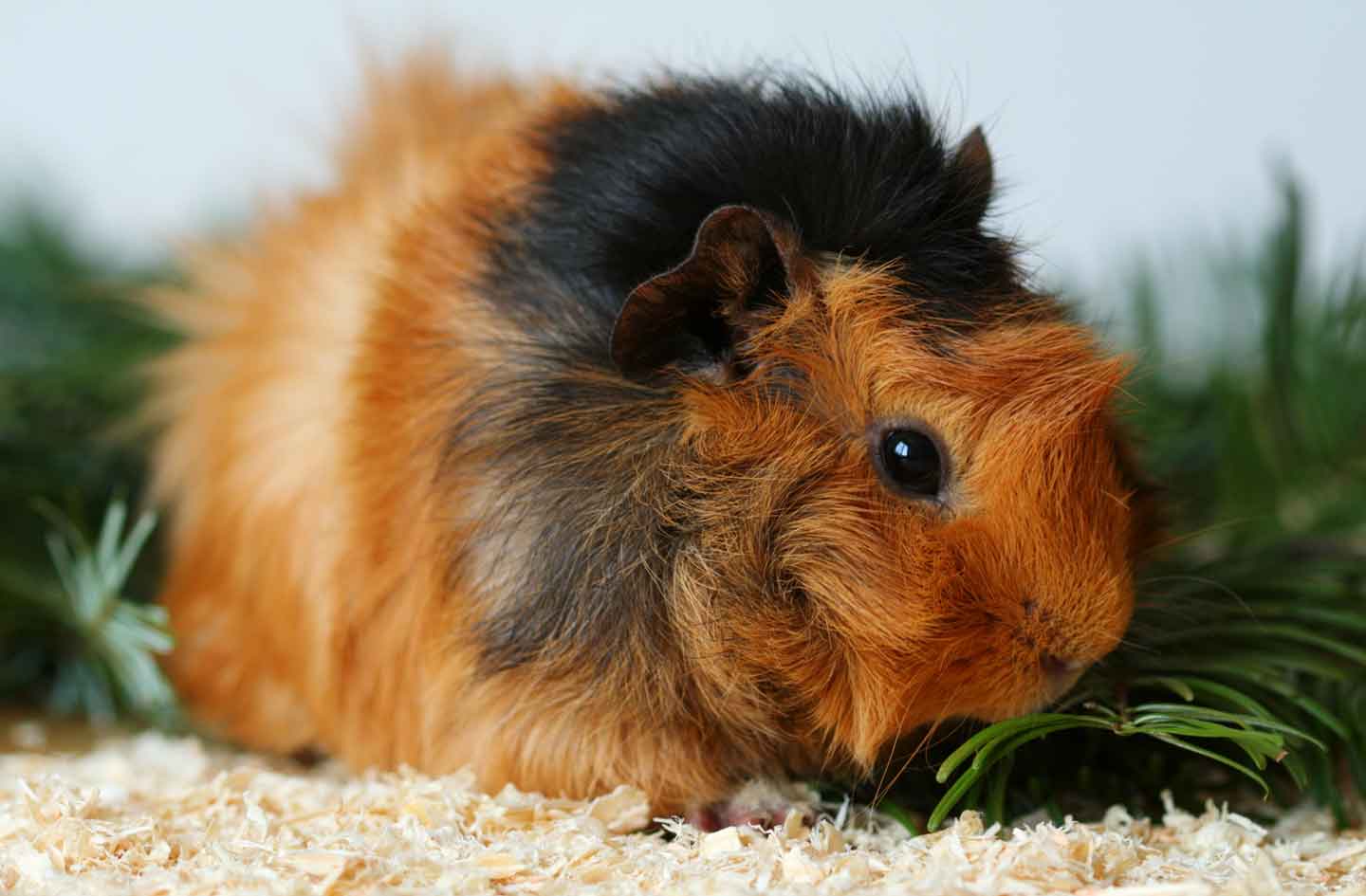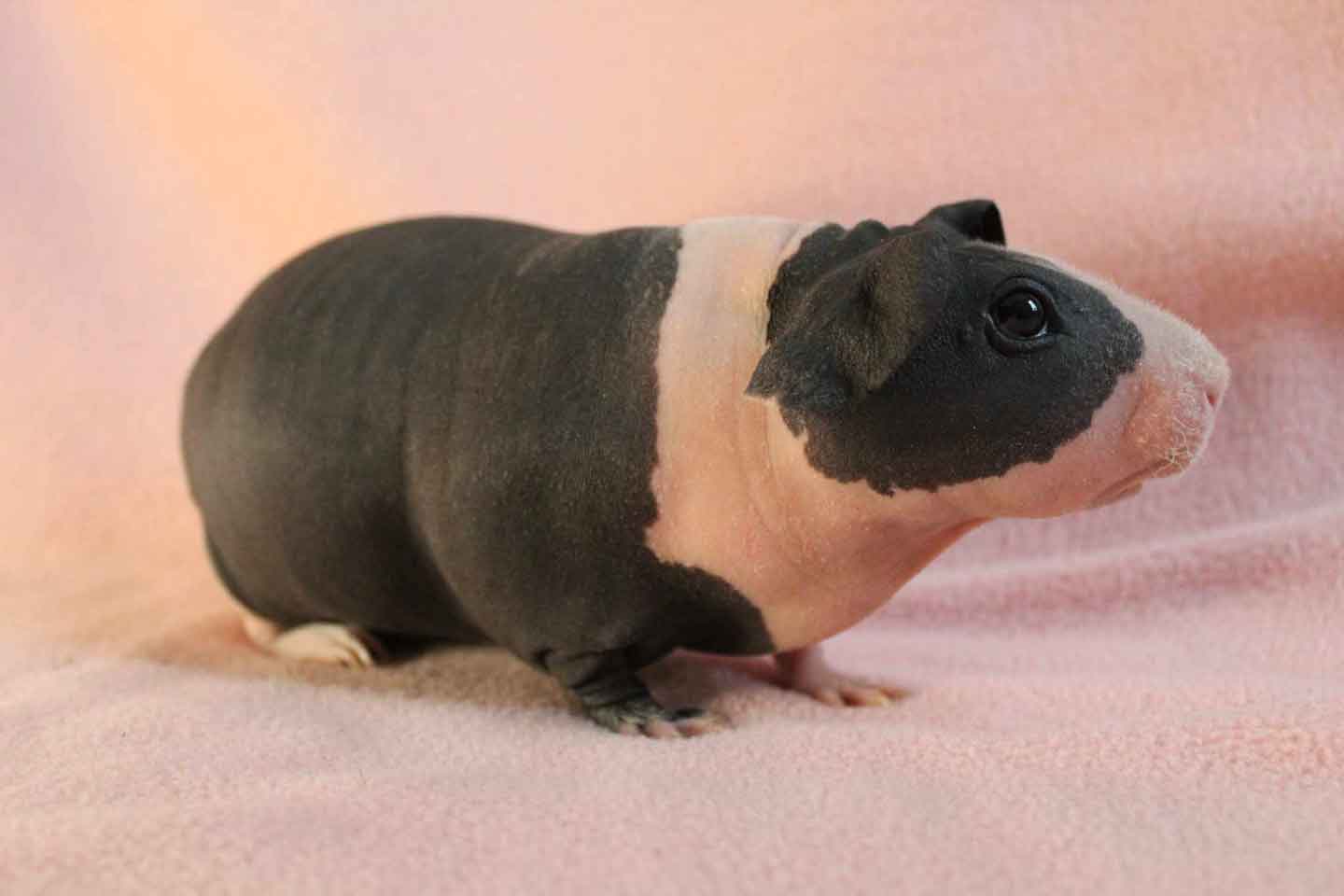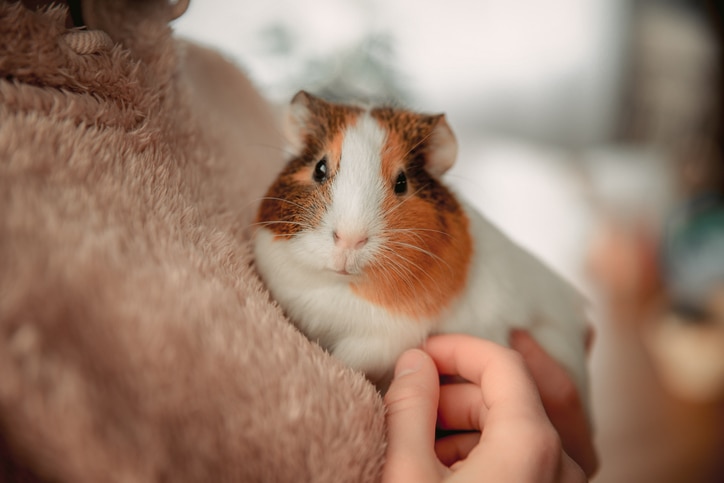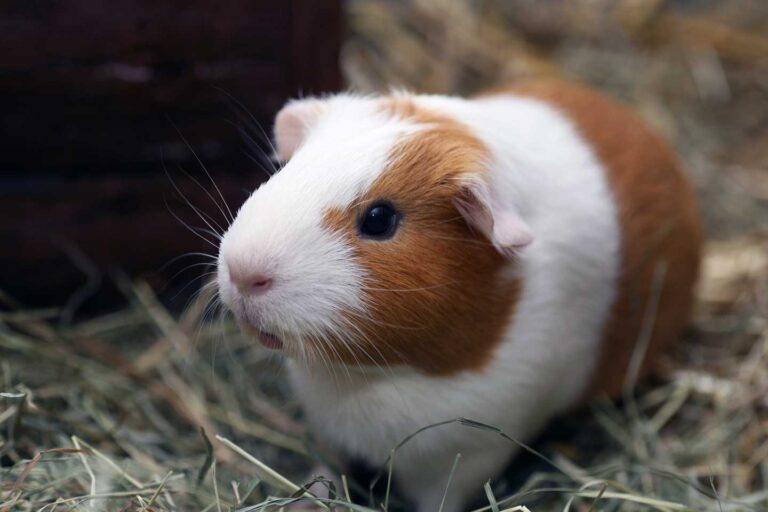The Ultimate Guide to Guinea Pig Breeds

Photo by mtreasure/iStock / Getty Images Plus
From their cuddly faces to their adorable behaviors, guinea pigs break the cuteness scale. While they all require the same general care, different types of guinea pigs can have needs that are unique to their breed, particularly long-haired, hairless, and satin piggies.
The American Cavy Breeders Association (ACBA) and American Rabbit Breeders Association (ARBA) promote responsible breeding and the improvement of guinea pigs. They currently recognize 13 breeds. Several other breeds are not yet recognized but well-known in the cavy community.
Below, we dive into the world of the many types of guinea pigs—both recognized and unrecognized breeds—and how to care for cavies.
Recognized Breeds
1. Abyssinian

svehlik/Adobe Stock
An Abyssinian guinea pig has beautifully disheveled hair with many cowlicks, or rosettes, all over their body. Abyssinians are known for their feisty and spicy behavior, and love attention, says Martha Panda, owner of Priceless Farms Caviary in Burnsville, Minnesota.
“A phrase that’s commonly used among breeds is that a good Abyssinian has ‘abytude,'” she says.
Abyssinians typically grow to be about 2 pounds. They’re referred to as the greyhounds of cavies, as they’re an athletic breed that loves to run, Panda says. In fact, they’re the only breed that in competitions is judged while moving.
2. Abyssinian Satin

Martha Panda
The Abyssinian satin is the Abyssinian but with a “satin” sheen coat. They’ll also have rosettes all over their bodies and coats that are harsh to the touch. Like Abysinnians, Abyssinian satins are quite active, says Susan Jones, cavy breeder and ARBA cavy registrar in Tucson, Arizona.
Satin guinea pigs’ shiny appearance is due to a genetic mutation, referred to as satin syndrome, says Erica Montefusco, ACBA District 3 director, ARBA registrar, and owner of Critters on the Move Caviary, in Omaha, Nebraska. This condition causes them to have difficulties breaking down and absorbing calcium in their body, which can result in health issues like neurological problems, skeletal abnormalities, and weakened immune systems.
Proper nutrition can prevent potential health problems. Satin cavies should be fed a diet slightly richer in vitamin C and calcium compared to regular-coated cavies. Additionally, long-haired guinea pigs should have a protein diet of 18%.
3. American

Wirestock/iStock / Getty Images Plus
If you’ve ever taken a gander at guinea pigs in a pet store, you’ve most definitely come across the American guinea pig. American guinea pigs are a common breed, and also the oldest breed of guinea pig, formerly known as the Smooth Coat.
Kody Keister, a cavy breeder and member of the ACBA and ARBA in Pennsylvania, describes American guinea pigs as “always curious” and “gentle.” These piggies have short coats that are dense, well-finished, and soft to the touch, he says. They come in many different varieties and generally grow to be about 3 pounds.
Keister considers Americans to be the best option for beginners, as they require straightforward care, and don’t need extensive grooming or upkeep compared to long-haired breeds.
4. American Satin

Oxilierer/iStock/Getty Images Plus
American satin guinea pigs are known for their friendly and sociable personalities, with plenty of curiosity and gentleness with their keepers. These cavies have glossy, lustrous coats with a sleek appearance. While their coats are generally easy to groom, it’s still important to remove loose hair, whether by brushing regularly or smoothing with a cloth. Montefusco says satin guinea pigs have the same standard and size expectations as regular-coated guinea pigs in the ARBA Standard of Perfection. While generally the same size, satin piggies can be smaller with poor breeding.
5. Coronet

Steven Tessy/iStock/Getty Images Plus
Coronet guinea pigs have majestic, long hair and a distinctive swirl, or rosette of hair, on top of their head—the defining characteristic of the breed.
“One of the biggest challenges with long-haired guinea pig breeds is preventing matting and tangles,” Montefusco says. “Because their hair is continuously growing, it’s more prone to tangling.”
This means you can expect regular grooming, such as brushing, bathing, and trimming, to be a part of your piggie’s routine.
Montefusco describes long-haired guinea pigs’ personalities as “very mellow,” “very sweet,” and “cuddly.” She adds that they tend to talk a lot as youngsters and grow quieter with age.
6. Peruvian

Zheka-Boss/iStock/Getty Images Plus
7. Peruvian Satin

Susan Jones
Recognized in 1987, there’s no denying these piggies could be the face of a leading hair care brand. Peruvian satin guinea pigs have a satin sheen all over and are different in that their coat density is one-third of the density of a normal-coated cavy, Jones says. Because this is a satin guinea pig, their diet should contain more vitamin C and calcium.
Jones says the Peruvian satin’s care can be time-consuming if you want to continue to grow their hair, which grows about 1 inch per month. “Long-haired guinea pigs are a special commitment, and you should think about whether you have the extra time needed before adopting a long-haired animal,” she says.
8. Silkie

absolutimages/iStock/Getty Images Plus
The silkie guinea pig, also known as the Sheltie, is the same as a coronet—but without the rosette on their head. A silkie guinea pig’s hair grows back from the face. “The texture of their hair is soft and silky, hence the name, silkie,” Montefusco says.
As with other long-haired guinea pig breeds, silkies have hair that continues to grow throughout their lives and requires regular grooming. Montefusco adds that their hair is typically floor length (top of back to feet or floor level when sitting naturally) by 2 months old, while show pigs can have hair grow up to 18 inches once they’re a year old!
9. Silkie Satin

Erica Montefusco
Like the American satin and Peruvian satin, the silkie satin has a glossy, reflective sheen that’s similar to satin fabric, Montefusco says. Long-haired breeds like silkie satin guinea pigs are wonderful, friendly choices for anyone committed to giving occasional haircuts and partial baths, she adds: “If you keep the hair trimmed to a tidy length, they require no more care than any other guinea pig on a day-to-day basis.”
10. Teddy

Photo
Teddy guinea pigs have a fuzzy appearance, like a teddy bear (hence the name). They can be seen in several colors, and their coats are dense, even in length. and give some pushback when touched. “A lot of people say that a teddy’s coat should feel like a Brillo pad,” says Dan Main, owner of Mainly Meadows in Coatesville, Pennsylvania. Main says Teddies can range in size, with some boars (male cavies) weighing over 3 pounds and sows (female cavies) reaching 2.2–2.5 pounds.
“They tend to have sweet, laid-back personalities,” Main says. “Many of my pigs love chin scratches, and run up to the front of the cage for snacks and pets! They’re fun, goofy little animals.”
11. Teddy Satin

Jessica Butler
Teddy satin guinea pigs have coats that are very similar to a regular Teddy, except they have sheen, says Jessica Butler, cavy breeder and owner at Celtic Caviary in northern Michigan. She considers Teddy satins to be a friendly, curious, and outgoing breed. While genetics and diet can impact a guinea pig’s size regardless of breed, she says Teddy satins are generally between 32–48 ounces and 10 inches in body length as full-grown adults.
A Teddy satin has short hair that’s even and kinky with an obvious sheen. Butler says their coat is easy to maintain with regular brushing. “They can be prone to dry or flaky skin, so it is important to brush them often to keep their dense coats free from debris,” she says. Unlike other guinea pig breeds, Teddy and Teddy satin guinea pigs should be brushed from rump to head due to the hair growth pattern.
12. Texel

joannawnuk/iStock/Getty Images Plus
13. White Crested

Anton Litvintsev/iStock/Getty Images Plus
The white crested has a smooth coat like the American, but with a signature white crest on the top of the head. “They tend to have a very fun and adventurous personality,” says Thad Ritch de Herrera, cavy breeder and owner at The Furball Fiesta in Wallingford, Pennsylvania. “They’re outgoing and inquisitive, as well as a bit more active than some other breeds.”
He adds that white crested guinea pigs are bold and engaging, and will often climb right up on an unsuspecting person in order to receive pets. These playful piggies love chew toys made from timothy hay or guinea pig-safe wood.
Unrecognized Breeds
1. Baldwin

The Baldwin is one of the two types of hairless guinea pigs. Baldwin guinea pigs are born with a full coat of fur that progressively falls out until they’re nearly hairless, with the exception of their whiskers.
Due to their lack of fur, Tyler Baum, DVM, exotic veterinarian at Broadway Veterinary Hospital in Sacramento, California, considers the Baldwin an ideal choice for people who are allergic to pet dander. However, they will require special care to maintain their body temperature and skin health: “They should be kept in a warm environment and may need moisturizing to prevent dry skin,” he says.
2. Skinny

Naomi Williams
The skinny pig is a hairless guinea pig who resembles a mini hippo. Ideally, a skinny pig only has hair on their face and legs, says Naomi Williams, owner of Faithful Friends Caviary in Wilmington, Ohio. Skinny pigs with more hair on their bodies past the ears are known as werewolf skinny pigs, which is a variation of this fairly new breed.
Skinny pigs measure 12–14 inches long on average, with sows weighing between 32–43 ounces and boars weighing 43–49 ounces.
“Skinnies oftentimes tend to be on the bubbly and sassier side of the personality spectrum,” Williams says. “They have an opinion and aren’t afraid to let everyone know what it is, while also remaining playful.”
Due to their lack of mere peach fuzz, they require steady room temperatures between 72–75 degrees Fahrenheit, making fuzzy blankets and space heaters a must. Additionally, skinny pigs need unlimited pellets to stay warm, since they have a higher metabolism compared to regular breeds. They also need a higher-protein pellet, with no less than 18% protein to help them maintain healthy skin.
3. Alpaca

mtreasure/iStock/Getty Images Plus
While similar in appearance to a texel guinea pig, the alpaca has longer, curly hair. Alpaca guinea pigs’ coats resemble that of, well, an alpaca, and require regular grooming to prevent tangling and matting, Dr. Baum says. They come in various colors and patterns, and are known for their gentle temperament. As with any other long-haired breed, regular grooming is a must, since they’re susceptible to getting debris and bedding stuck in their coat.
4. Lunkarya

alieshia/iStock/Getty Images Plus
5. Sheba

DigitalAppeal/iStock/Getty Images Plus
The Sheba is a guinea pig breed recognized in Australia. Sheba guinea pigs resemble Abyssinians and Peruvians thanks to their longer, tousled hair and rosettes, and are sometimes called the “bad hair day cavy.” Wynne Eecen, founder of the New South Wales (NSW) Cavy Club in Australia, created the Sheba in 1969. She nicknamed it the Sheba Mini Yak due to its yak-like appearance. Like other medium and long-haired guinea pig breeds, their hair will require routine grooming to keep it healthy and tidy.
6. Swiss

GlobalP/iStock/Getty Images Plus
Caring for Guinea Pigs
Compared to some other pets, guinea pigs are relatively low-maintenance. However, they require time, love, and attention to meet their specific needs, just as any other animal.
Diet
A guinea pig’s diet should be well-balanced and consist of about 70–80% hay; 20–30% greens; and a limited amount of pellets daily.
Like people, guinea pigs can’t produce vitamin C themselves. This means it should be included in their daily diet to avoid potential health problems, particularly scurvy.
Guinea pigs should also have access to fresh, clean water daily.
Habitat
Your guinea pig’s habitat is where they’ll spend most of their time. This can be an enclosure in the form of a cage or playpen, depending on your preferences.
When setting up your guinea pig’s habitat, Dr. Baum shares these essential tips:
- Use paper-based or fleece bedding. Avoid cedar and pine shavings due to harmful oils.
- Provide at least one hiding spot per guinea pig.
- Make sure their water bottle is always full of fresh water.
- Use heavy, tip-resistant food dishes for pellets.
- Use a hay rack to keep your guinea pig’s hay clean and accessible.
- Provide chew toys made of guinea pig-safe wood or cardboard to maintain their dental health.
- Optional: Place a guinea pig corner litter box in the habitat and train your piggie to make that their designated potty area.
Handling
Guinea pigs are known as pocket pets. And while they’re easy to pick up, knowing how to handle them is important for their health and safety. Follow these tips:
- Always handle your pet with two hands.
- Cradle them when you’re standing up and holding them.
- When teaching a young child or adult how to handle them, it may be helpful to wrap the guinea pig in a towel, like a burrito.
- Never leave them unattended on high surfaces, such as a sofa or counter.
When To See a Vet
Caring for a guinea pig requires regular vet visits.
“Young guinea pigs should have a wellness checkup with blood work performed once a year,” says Susan Tyson, VMD, MS, veterinarian and owner at Avian & Exotic Philly Vet Medical Surgical Clinic in Philadelphia. “After age 4, those visits should be performed every 4–6 months depending on their health status.”
According to Dr. Tyson, signs a guinea pig may need to see a veterinarian include:
- Decreased appetite
- Not eating or drinking
- Hiding
- Irregular stool (i.e., small, abnormally shaped diarrhea)
- Labored or congested breathing
- Straining to urinate or not urinating for more than 12 hours
- Drinking more water than usual
- Head tilt
- Weakness in legs
- Sudden difficulty walking
FAQs About Types of Guinea Pigs
What is the friendliest breed of guinea pig?
Each guinea pig will have a different personality regardless of breed. If you’re looking for a breed best suited for a first-time guinea pig parent, a short-haired breed will require less time and maintenance compared to a long-haired breed.
How many guinea pig breeds are there?
Thirteen guinea pig breeds are currently recognized by the ARBA and ACBA. However, there are several other breeds not yet recognized by those organizations. The British Cavy Council recognizes over 50 breeds.
Guinea pigs make wonderful furry companions. While they require the same general care in regard to their diet, housing, and handling, each breed can vary in nutritional, grooming, and even temperature needs. It’s always best to research the type of guinea pig you’re interested in adopting to learn if it’s the right choice for you.
Attributions
This content was medically reviewed by Chewy vets.











